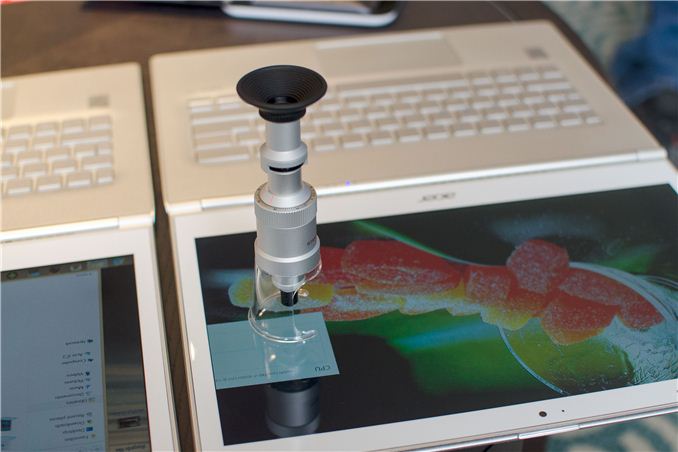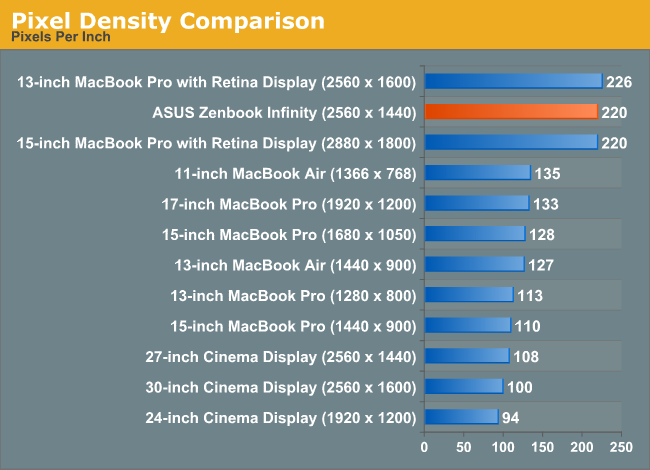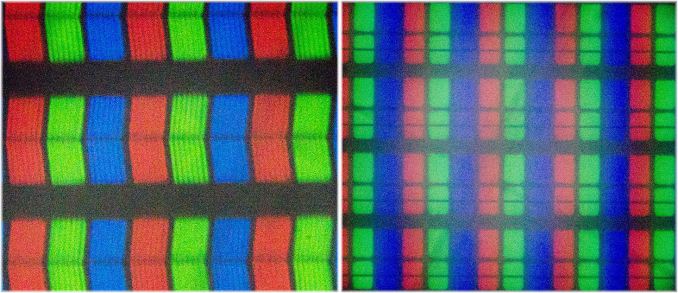Up Close with the 13.3-inch 2560 x 1440 Panel on Next-Gen Ultrabooks
by Anand Lal Shimpi on June 6, 2013 9:05 PM EST
Although entry level PC notebooks will still ship with a 1366 x 768 panel, the high end of the market is quickly shifting to 1080p and higher resolution panels. Some of the most interesting notebooks at Computex launched with high DPI panels, such as the new Acer Aspire S7 and the ASUS Zenbook Infinity - both with 13.3" 2560 x 1440 displays. These displays offer comparable pixel density to Apple's MacBook Pro with Retina Display.

Intel had one of the 2560 x 1440 Aspire S7s at their Computex suite as well as a microscope for showing off the difference in pixel size. With a 33% increase in pixel density, the 2560 x 1440 panel obviously has smaller pixels.
There's nothing new about increasing pixel density, however OS support/integration is just as important to the overall experience as physically outfitting notebooks with high DPI panels. Windows has traditionally done a terrible job of DPI scaling on the desktop, but word around Computex is that this should be fixed with Windows 8.1.











38 Comments
View All Comments
xTRICKYxx - Thursday, June 6, 2013 - link
I think the days of 1366x768 Displays are behind us!hypopraxia - Thursday, June 6, 2013 - link
I sure hope.Gigaplex - Thursday, June 6, 2013 - link
They'll still be around for years and years at the low end of the market. Hopefully they'll soon vanish completely from the mid range gear.tipoo - Friday, June 7, 2013 - link
Yet Apple still uses 1280x800 on laptops over 1000 dollars :/Guspaz - Friday, June 7, 2013 - link
Apple does not ship any laptops that cost more (by default) than their retina equivalents. There are still trade-offs to high resolution displays, cost being one of them (power being the other). I suspect Apple will migrate all their notebooks to high DPI displays when they can (as costs go down and power efficiency goes up), but Haswell is the first generation that makes a high DPI ultrabook (or mac air) feasible.In fact, much like Haswell has lead to some high DPI Ultrabook announcements, I suspect it will lead to Apple pushing their migration to retina displays a bit further. They may introduce a 13-inch retina Air (the 11 inch is a lot less likely at this point for cost/power reasons), or they may complete the migration of one of the Pro notebooks by discontinuing the non-retina version.
gochichi - Thursday, June 6, 2013 - link
PC manufacturers will follow Apple off a cliff like idiot lemmings. 13" 1080P is enough if not more than enough, but Apple (a premium brand, "the premium brand") decides to distinguish itself with 1600P on 13" and that's completely fine for them to do. But why oh why would lost, fragmented PC makers follow? It's ridiculous, who's making these decisions?... I swear the majority of your readers could advise these companies straight to the top. Super pixel density is already claimed, Apple claimed it (good for them, it's neat, it's great). Let Apple have that and claim all that is obvious, practical, useful and unclaimed... 15" 1920x1200, 15" 2560x1440, 17" 2560x1440. I'm typing this on a 13" 1080P glossy screen and I want more brightness and that's all I want, otherwise it's freaking "perfect". I'm not a manufacturing genius, but I have to imagine that doing a screen like this one but 17" and 1440P can't be that hard. What am I missing? Why do we as customers/users have to live in constant frustration from the horrid company choices?jaroche - Thursday, June 6, 2013 - link
But finally PC makers are shipping IPS high resolution displays, thanks to the Retina Display BS.pixelstuff - Thursday, June 6, 2013 - link
The goal should be 300 dpi displays and an OS that can draw the interface based in standard world dimensions (like inches or centimeters) instead of pixels. I'm all for higher dpi displays.Guspaz - Friday, June 7, 2013 - link
It's not a simple problem to solve; if you standardize on real-world measurements ("this dialog box is 3 inches wide"), then something that works well on a 27" screen will be a horrible experience on a 11" screen.A better solution may be to decouple render resolution and display resolution entirely. Instead of varying the display resolution, vary the render resolution. So if your display is 2560x1440, your backbuffer that you render to might be anything from 2560x1440 to 5120x2880, but a dialog box might always be 200 pixels wide. By varying the resolution of the backbuffer, you can change the size of the dialog box on-screen without losing detail (because you're always downscaling for display).
I believe Apple took an approach similar to this, and I hope Microsoft does as well.
inighthawki - Friday, June 7, 2013 - link
Just because you're downscaling doesn't mean it will always look good. Even at a perfect 1/2 scale you will get awkward looking text and images that still need to apply filtering. That and rendering at something like 5120x2880 just for the purpose of downscaling later is a huge waste in gpu performance and screen composition.